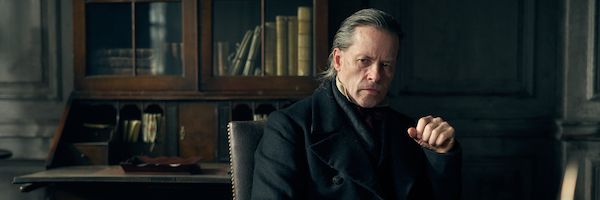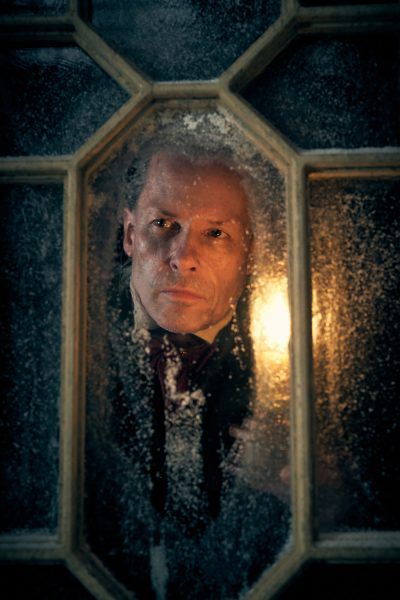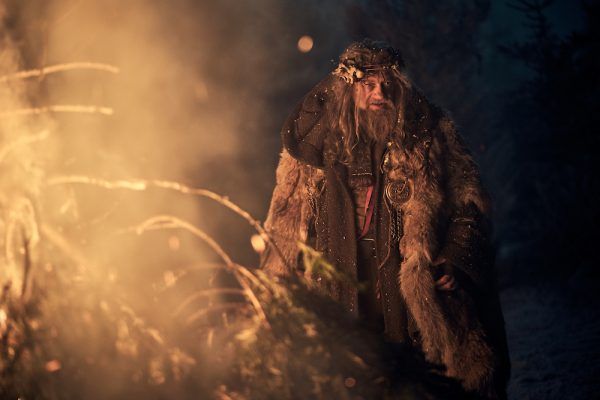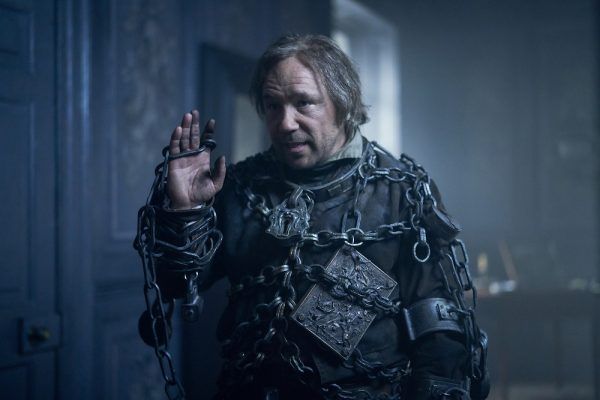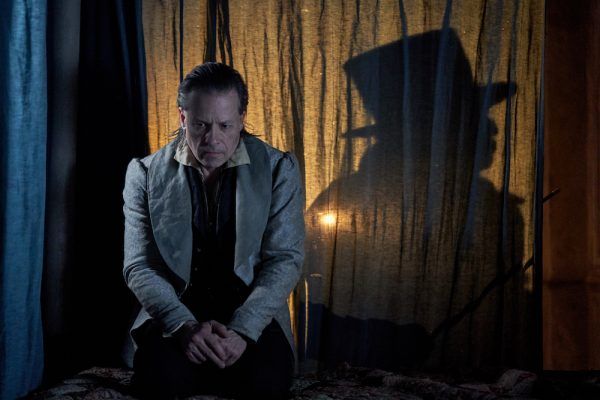Writer Steven Knight (Eastern Promises, Peaky Blinders) and director Nick Murphy (The Awakening) have delivered a dark, violent, and deeply disturbing adaptation of Charles Dickens' classic redemption story A Christmas Carol. It's not hyperbole to say that the three-hour FX event is superlative in all of those categories, taking the darkest descriptions of Dickens' Scrooge and the Spirits that visit him and twisting them further, not quite beyond recognition, but very near to the point of no return. And in doing so, Knight, Murphy and FX may have plumbed the depths of the soul and the human condition, but they were so consumed by the darkness of A Christmas Carol that they forgot to let the light shine in at the end.
A Christmas Carol is a dark story, a rather spooky ghost story in large part, but its greatest effect is in illuminating the pain and misery one poor unfortunate soul inflicts on the multitudes around him, and then reflecting that reality back upon him in the hopes of pushing him towards redemption. You need both parts for the story to work. Had Dickens' original Scrooge either refused to change his ways or simply resign himself to his fate, the story would not have become a classic because it would have lacked both the narrative punch of a complete character arc and the feel-good moment of redemption. Without this change of heart, there's literally no point to the story whatsoever.
Knight's adaptation of A Christmas Carol doesn't quite go to this nihilistic extreme, but it gets damn close. I appreciate its exploration of just how dark a 19th century Scrooge could have gone; I actually applaud this version for bringing some rawness and grit to a story that's become somewhat sanitized in popular adaptations to date. For the bulk of the telling, A Christmas Carol should scare the coal out of both good and sinful people the world over, because it's an exposé of all of us at our worst moments, a critique of humankind and how we behave on every day of the year except for those where holiday traditions demand we actually be civil for once. Knight's script glorifies in diving headfirst into the multitude of sins committed by Scrooge and partner Jacob Marley, just as much as he loves letting Scrooge wax philosophically about just how awful every human being is (except for himself and Marley, of course). He also delights in lording punishment over Scrooge (via the Spirits) and over everyone Scrooge encounters, via Scrooge himself. That tension extends to the audience who watches as this Sword of Damocles threatens to fall at any time, regardless of how well they know Dickens' original story. So while Knight pays homage to both classic moments in the 176-year-old tale and adaptations gone by, as well as adding his own clever twists and turns to the narrative, neither Scrooge nor the audience is given a chance to breathe free and celebrate joyously. That's a missed opportunity that robs the story of its redemptive power.
So what works for this version of A Christmas Carol? For starters, the cast. Guy Pearce, at 52, is a lot younger than we're used to seeing Ebenezer Scrooge, meaning that he has to be that much crueler to catch up to his older counterparts in terms of sins. We get to spend quite a bit of time with Stephen Graham's Jacob Marley, much more than we normally do in such adaptations; he also has the unenviable distinction of being both the most pissed-off and pissed-on version of Marley ever to grace the screen. The Cratchits are a fine, upstanding, and empathetic family as well, led by patriarch Bob (Joe Alwyn) and his wife Mary (Vinette Robinson), with youngsters Belinda (Tiarna Williams) and the delightful Tiny Tim (Lenny Rush) in tow.
But it's the Spirits that steal the show, specifically Andy Serkis' bizarro Ghost of Christmas Past, with a twist from Kayvan Novak's Ali Baba, as well as Charlotte Riley pulling double duty as both Scrooge's sister Lottie and her spectral form as the Spirit of Christmas Present (more on that change in a moment), and Jason Flemyng's tight-lipped (and tied-lipped) Ghost of Christmas Future. The changes to each of these spirits are interesting ones: Christmas Past is traditionally androgynous and sports a flame or fire motif; Serkis' spirit, which accompanies Scrooge for a solid hour of the special after another hour spent in the prologue, is more of a half-blind (one eye on the past, you see) mad woodsman, tasked with burning memories of Christmases past on a great bonfire, and I love this redesign. He relishes the challenge that Scrooge poses, attempting to force the miserly miscreant to crack by showing him an endless alternating parade of both his happiest and most traumatic moments. (Spoiler: It doesn't quite work.)
So it's to the Present we go. Normally, this spirit is a vast and jovial Santa Claus type; not so in Knight's version. Instead, it's another gut punch for Scrooge as his late sister Lottie guides him through the present tragedies on that very Christmas Day. (Here's your first hint that Knight's take will simply refuse a celebratory atmosphere in every possible way.) From there, it's on to the Ghost of Christmas Future, or the Spirit of Christmases Yet to Come. Traditionally terrifying, this spectre starts out as a shrouded, bell-swinging horror, like something out of a Dark Souls game, but unfortunately once the hood is literally pulled back, the effect is not scary at all.
Something this version of A Christmas Carol does exceptionally well, however, is that it throws audiences for a loop whenever Scrooge trips through space and time. Murphy takes us from the safety of Scrooge's expansive manor home into the fiery hell that is a factory aflame, its fire running unchecked due to scrimping on safety measures under Scrooge and Marley's watch, or into a collapsing mine shaft that claims the lives of miners and horses alike due to Scrooge and Marley cutting back the timber supply used to shore up the passage. We see Scrooge's office become the underside of a frozen lake, watching in horror along with him as someone breaks through the thin ice and drowns in midair. That's dark stuff, intentionally so, and it's done to shock Scrooge out of his complacency and bring him face to face with his awful past in the hopes that he might repent. But it's here that we get the biggest change to the story so far.
Knight wants his Scrooge to be both a mustache-twirling villain who uses facts and figures to make each and every cold, calculated decision regardless of the human or emotional costs involved, but he also wants us to empathize with Scrooge well before there's any hint of repentance. That idea in and of itself isn't new; we've seen Scrooge's troubled boyhood days left alone over the holiday break at a boarding school, or suffering in silence at the death of his sister or the heartbreaking dissolution of his romantic relationships. That used to be enough to humanize Scrooge. Now, Knight has to take that idea to extremes. Abuse of all kinds afflicts the young Scrooge in just about every way imaginable. The adult Scrooge uses this reality as an excuse to harden his heart and treat everyone around him with contempt and disdain, and it's only when he can voice these past pains against him that he's able to move forward. So while the harsh reality of his life definitely comes across (and it'd be very hard to miss it), there are moments that take that darkness to an unnecessary extreme.
That would be fine if Scrooge was offered the time and opportunity to bounce back in the other direction. Some of the best moments from other adaptations of A Christmas Carol come while watching Scrooge act like a lighthearted boy once more, despite his advanced age and notorious reputation as a cruel miser and skinflint. Pearce's Scrooge is robbed of this. His character is taken so far into the darkness that basic empathy and care for another human being is as close as he can get to joy, happiness, and reveling in the Christmas spirit. This Scrooge is not hollering from top-floor windows for Christmas goose or dancing around his bedroom with a song in his heart and a spring in his step. He's not nearly as endearingly loony as Patrick Stewart, Tim Curry, Michael Caine, George C. Scott, Bill Murray, Reginald Owen, or Alastair Sim, and that's a shame, because Pearce has the talent to let loose but the gravitational pull of this version's dark subject material just wouldn't let him go.
FX's A Christmas Carol certainly brings something new to the tried-and-true story and it's worth a watch for that alone. It plumbs the depths of darkness to the point that even the usually buoyant Cratchit Family is dragged down with Scrooge. But without a redemptive rise to counterbalance all that darkness, A Christmas Carol misses out on the meaning of the story and the greater meaning of the Christmas season.
Rating: ★★ Fair
FX’s A Christmas Carol premieres tonight at 7:30p ET/PT.

